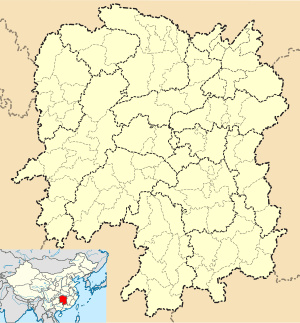Baiyun Temple
| Baiyun Temple | |
|---|---|
| 白云寺 | |
|
The torii gate. | |
 Shown within Hunan | |
| Basic information | |
| Location | Ningxiang County, Changsha, Hunan |
| Geographic coordinates | 28°06′33″N 112°20′14″E / 28.10917°N 112.33722°ECoordinates: 28°06′33″N 112°20′14″E / 28.10917°N 112.33722°E |
| Affiliation | Guiyang school |
| Country | China |
| Architectural description | |
| Founder | Guang'en |
| Completed | AD 858 |
Baiyun Temple(simplified Chinese: 白云寺; traditional Chinese: 白雲寺; pinyin: Baíyún Sì), built in the twelfth year of the age of Da Zhong of Tang Xuanzong in the Tang Dynasty (AD 858). It is listed on the culture relic preservations of Changsha city, where Mao Zedong did social research in 1917. With a superbly vast outlook, it serves as an important site for Buddhist activities. It includes the Entrance, Torii, Deities Hall, Hall of the Great Heroes, Assisted dnyana, Dining Room, etc.[1]
History
Tang Dynasty
In 858, in the twelfth year of the age of Dazhong of Tang Xuanzong, monk Guang'en (光恩禅师) built Qinglin Temple (清林寺) in Su Rever, Huilong Mountain (回龙山粟溪).[1]
Ming Dynasty
Wang Bi (王陛) and his son Wang Weihan (王维汉) extended Baiyun Temple.[2]
Qing Dynasty
In 1646, in the third year of the age of Shunzhi of Shunzhi Emperor, Tao Runai (陶汝鼐) rebuilt Baiyun Temple.[2]
In the period of the Qianlong Emperor, Wanxing (万行) rebuilt Baiyun Temple.[2] In 1763, in the twenty-eighth year of the age of the Qianlong Emperor, Qinglin Temple and Baiyun Temple were consolidated and renamed Baiyun Temple.[2]
In the period of the Daoguang Emperor, the monks rebuilt Baiyun Temple.[2]
People's Republic of China
In 1988, the People's Government of Ningxiang County rebuilt Baiyun Temple.[2] In 1900, the Ningxiang Buddhist Association was set up in Baiyun Temple.[1]
References
| Wikimedia Commons has media related to Bai Yun Temple. |